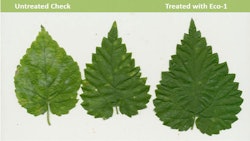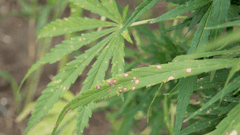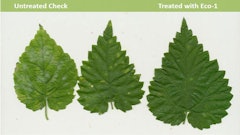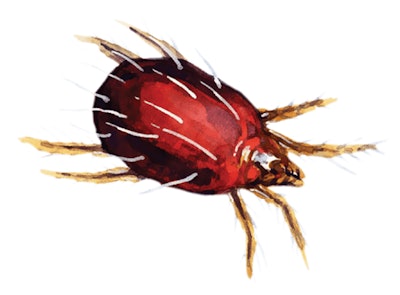
Biological control is a plant protection strategy used in different horticultural cropping systems that minimizes plant damage to promote plant health, avoid reduced yields, and ensure plants are marketable. Biological control entails releasing parasitoids or predators that will regulate insect or mite pest populations. The primary parasitoids and predators used in greenhouses and indoor environments are affiliated with aphid parasitoids and predatory mites.
The following article is the second of a two-part series that describes commercially available parasitoids and predators, which can be purchased from biological control suppliers and then released to regulate insect or mite pest populations on cannabis crops. Here, we examine the predatory mites that attack fungus gnats, mites, thrips, and whiteflies. (Editor’s Note: Read the first article in the series here.)
For some of the predatory mites mentioned, there is no information for certain factors such as optimal (ideal) conditions for predation.Predatory Mites: Type I, II and III
Predatory mite behavior needs to be understood before release because their ability to regulate specific insect or mite pests is primarily dependent on feeding habit, though plant volatiles (i.e. odors emitted by plants when fed upon by herbivores that may attract certain predatory mites such as Phytoseiulus persimilis) and dispersal can also affect regulation. Predatory mites are classified into three categories: Type I, II, and III, based on their food preferences and dispersal capabilities among and within plants.
Type I
Type I predatory mites are specialists because they only feed on spider mites in the family Tetranychidae, which includes the twospotted spider mite, Tetranychus urticae. Type I predatory mites tend to aggregate on plants and remain in prey patches longer than other predatory mites. An example of a Type I predatory mite is Phytoseiulus persimilis. This mite responds rapidly to increases in twospotted spider mite populations. However, this may result in predatory mite populations declining because P. persimilis cannot survive on an alternate food source. Populations of P. persimilis will cannibalize each other in the absence of twospotted spider mites. Therefore, it may be difficult to locate these predatory mites on plants after reducing twospotted spider mite populations.
Type II
Type II predatory mites selectively feed on a broad range of mite pests and pollen and will not cannibalize each other like P. persimilis. Examples of Type II predatory mites include Neoseiulus californicus, N. cucumeris, N. fallacis, and Galendromus occidentalis.
Type III
Type III predatory mites are generalist feeders that will feed on a wide range of mite pests including broad mite, Polyphagotarsonemus latus; cyclamen mite, Phytonemus pallidus; and russet mites (eriophyids). In addition, Type III predatory mites will feed on pollen and plant exudates (compounds produced by plants) as an alternate food source. Type III predatory mites tend to aggregate on plants less so than Type I and II predatory mites. Amblyseius swirskii is an example of a Type III predatory mite, which feeds on western flower thrips (Frankliniella occidentalis), greenhouse whitefly (Trialeurodes vaporariorum), and sweetpotato whitefly (Bemisia tabaci).
The classifications presented above are simple generalizations because there are exceptions. For example, N. californicus has characteristics affiliated with a Type II (selective) and Type III (generalist) predatory mite. Table 1 (p. 42) lists predatory mites and the targeted insect or mite pests, and here are more details about the specific attributes of each.
Phytoseiulus persimilis
- Prey: Phytoseiulus persimilis only attacks twospotted spider mites, and both nymphs and adults actively search for and feed on all life stages (eggs, larvae, nymphs, and adults). Phytoseiulus persimilis is a very effective predatory mite and may even eliminate a twospotted spider mite population on a cannabis crop. Consequently, growers who are only dealing with twospotted spider mite may want to select this predatory mite.
- Identification: Adult Phytoseiulus persimilis females are 1.25 mm long, pear-shaped, and orange to bright red. Phytoseiulus persimilis adults are larger and move faster than twospotted spider mite adults.
- Ideal conditions: Phytoseiulus persimilis is most active at temperatures between 54°F and 80°F and when the relative humidity is between 60% and 70%. At temperatures between 68°F and 72°F, P. persimilis develops from egg to adult twice as fast as the twospotted spider mite. However, a relative humidity greater than 90% or less than 55% will decrease egg survival. Furthermore, when temperatures are 95°F, predatory mites migrate down the plant and reside in the lower plant canopy, which is cooler than the upper canopy. Predatory mite distribution is enhanced among a crop when plant leaves are touching. However, movement is inhibited on leaves with sticky hairs such as those associated with tomato, Solanum lycopersicum.
- Lifespan and feeding: Females lay (oviposit) approximately 60 eggs during their 50-day lifespan. P. persimilis can consume up to 20 eggs, larvae, or nymphs per day.
P. persimilis can eliminate a twospotted spider mite population, which means that additional releases will be required when twospotted spider mites return.
Neoseiulus (Amblyseius) cucumeris
- Prey: Neoseiulus cucumeris feeds on western flower thrips, broad mite, cyclamen mite, and tomato russet mite (Aculops lycopersici). The predatory mite only attacks the first stage larvae of the western flower thrips. However, they can indirectly affect second stage larvae through intimidation, which may reduce the number of western flower thrips that pupate in the growing medium.
- Identification: Adult females are 1.25 mm long and pale brown.
- Ideal conditions: Neoseiulus cucumeris is active when temperatures are between 60°F and 86°F.
- Lifespan and feeding: Neoseiulus cucumeris adults consume one prey per day and will feed on pollen as an alternate food source in the absence of prey, which is beneficial in sustaining predator populations. Females can lay up to 35 eggs during a 30-day lifespan.
Neoseiulus (Amblyseius) californicus
- Prey: Neoseiulus californicus feeds on the twospotted spider mite, broad mite, and cyclamen mite. Moreover, the predatory mite will feed on pollen as an alternate food source in the absence of prey.
- Identification: Neoseiulus californicus adult females are 1.25 mm long, pear-shaped, and ivory colored.
- Ideal conditions: Development from egg to adult takes 10 days at 70°F and five days at 86°F.
- Lifespan and feeding: Females lay more than 60 eggs during their 20-day lifespan.
Females attach eggs to hairs on the underside of leaves along the veins close to mite colonies. The predatory mite tolerates higher temperatures and a lower relative humidity that P. persimilis. However, N. californicus has a lower rate of population growth, and females lay fewer eggs than P. persimilis.
Neoseiulus (Amblyseius) fallacis
- Prey: Neoseiulus fallacis feeds on many different types of mites including twospotted spider mite, broad mite, cyclamen mite, and russet mites. In addition, the predatory mite will feed on pollen as an alternate food source in the absence of prey.
- Identification: Adults are 1.25 mm long, pear-shaped, and initially ivory-colored. They turn red-brown after consuming prey.
- Lifespan and feeding: Adult females can consume up to 16 mites per day and can lay up to 60 eggs during a 14- to 60-day lifespan. The lifecycle (egg to adult) takes seven to nine days; however, development depends on temperature. Neoseiulus fallacis tolerates cooler temperatures than most predatory mites.
Amblyseius andersoni
- Prey: Amblyseius andersoni attacks a variety of mites, including twospotted spider mite, broad mite, cyclamen mite, and russet mites. Nymphs and adults of the predatory mite feed on all life stages (eggs, larvae, nymphs, and adults) of prey. Furthermore, A. andersoni will feed on pollen, fungal spores, and plant exudates as alternate food sources in the absence of prey.
- Identification: Amblyseius andersoni is approximately 1.0 mm in length and light-brown to orange.
- Ideal conditions: The predatory mite is active at temperatures above 50°F.
- Lifespan and feeding: Adult females lay approximately 35 eggs during their lifespan. Female adults attach eggs onto leaf hairs. Amblyseius andersoni will enter diapause (period of suspended development) in fall in greenhouses, and then overwinter in cracks and crevices. In indoor settings, the predatory mite enters a diapause indoors and then transitions into a non-diapausing stage when cannabis crops are present.
Amblyseius swirskii
- Prey: Amblyseius swirskii feeds on the first stage larvae of western flower thrips, as well as the eggs and nymphs of greenhouse and sweetpotato whiteflies. Amblyseius swirskii will feed on pollen as an alternate food source in the absence of prey.
- Identification: Amblyseius swirskii is similar in appearance and size to Neoseiulus cucumeris.
- Ideal conditions: Amblyseius swirskii is active at temperatures around 77°F with optimum temperatures for development, foraging, and reproduction between 77°F and 83°F. A relative humidity >70% prevents eggs and larvae from drying up (desiccating).
- Lifespan and feeding: The predatory mite can consume up to 10 western flower thrips, 10 whitefly nymphs, or 20 whitefly eggs per day. Female adults lay two eggs per day, although this is contingent on prey type. Adult females lay eggs on leaf hairs. Amblyseius swirskii can be combined with other biological control agents.
Galendromus (Metaseiulus) occidentalis
- Prey: Galendromus occidentalis feeds on twospotted spider mite, broad mite, cyclamen mite, and tomato russet mite.
- Identification: Adults are initially white and turn brown to red depending on the prey fed upon.
- Ideal conditions: Galendromus occidentalis tolerates higher temperatures and a lower relative humidity than P. persimilis.
- Lifespan and feeding: Adults can consume up to 20 eggs during their 30-day lifespan. Development from egg to adult takes seven to 14 days depending on temperature.
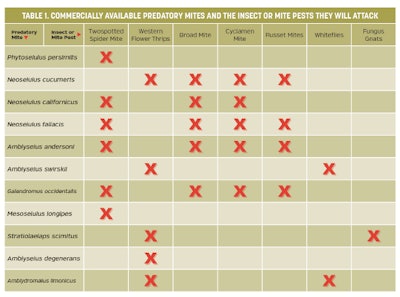
Mesoseiulus longipes
Prey: Mesoseiulus longipes feeds on various pest mites including the twospotted spider mite.
- Ideal conditions: The predatory mite tolerates higher temperatures and a lower relative humidity than P. persimilis.
- Lifespan and feeding: Females lay approximately 50 eggs during their 13- to 40-day lifespan.
Stratiolaelaps scimitus (formerly ‘Hypoaspis miles’)
- Prey: Stratiolaelaps scimitus is a soil-borne predatory mite that feeds on fungus gnat (Bradysia spp.) eggs, larvae, pupae and western flower thrips pupae. In addition, the predatory mite may feed on root aphids (Pemphigus spp.). Both the nymphs and adults are predaceous.
- Identification: Stratiolaelaps scimitus is brown and resides in the top 2.5 cm of the growing medium. The predatory mite can be used in conjunction with entomopathogenic (beneficial) nematodes such as Steinernema feltiae.
Amblyseius degenerans
- Prey: Amblyseius degenerans feeds on western flower thrips and will feed on pollen as an alternate food source in the absence of prey. Similar to N. cucumeris, A. degenerans will intimidate the larval stages of western flower thrips, which may reduce plant damage caused by western flower thrips feeding.
- Ideal conditions: The predatory mite tolerates a lower relative humidity and has a higher population growth than N. cucumeris.
Amblydromalus limonicus
- Prey: Amblydromalus limonicus feeds on western flower thrips and greenhouse whitefly. The predatory mite attacks the first and second stage larvae of western flower thrips. In addition, A. limonicus will feed on pollen from sweet pepper, Capsicum annuum, and other crops, as well as plant exudates as an alternate food source in the absence of prey.
- Ideal conditions: The optimum temperatures for development, foraging, and reproduction are between 55°F and 86°F.
- Lifespan and feeding: Female adults lay one egg per day. Amblydromalus limonicus does not undergo diapause in greenhouses during the winter, which means that the predatory mite will provide regulation of insect pest populations year-round.
In conclusion, it is important to correctly identify the insect or mite pest so you can purchase the appropriate predatory mite. In addition, you need to understand the feeding habit of the predatory mite released to ensure that the predatory mite will effectively regulate insect or mite pest populations, which will alleviate damage to your cannabis crop.






